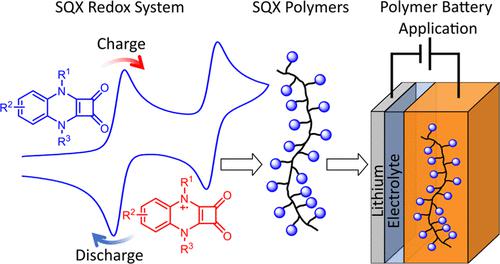当前位置:
X-MOL 学术
›
J. Am. Chem. Soc.
›
论文详情
Our official English website, www.x-mol.net, welcomes your
feedback! (Note: you will need to create a separate account there.)
From Squaric Acid Amides (SQAs) to Quinoxaline-Based SQAs─Evolution of a Redox-Active Cathode Material for Organic Polymer Batteries
Journal of the American Chemical Society ( IF 14.4 ) Pub Date : 2023-10-12 , DOI: 10.1021/jacs.3c09153 Marcel E Baumert 1 , Victoria Le 2 , Po-Hua Su 3, 4 , Yosuke Akae 2, 5 , Dominic Bresser 3, 4 , Patrick Théato 2, 6 , Max M Hansmann 1
Journal of the American Chemical Society ( IF 14.4 ) Pub Date : 2023-10-12 , DOI: 10.1021/jacs.3c09153 Marcel E Baumert 1 , Victoria Le 2 , Po-Hua Su 3, 4 , Yosuke Akae 2, 5 , Dominic Bresser 3, 4 , Patrick Théato 2, 6 , Max M Hansmann 1
Affiliation

|
The search for new redox-active organic materials (ROMs) is essential for the development of sustainable energy-storage solutions. In this study, we present a new class of cyclobuta[b]quinoxaline-1,2-diones or squaric acid quinoxalines (SQXs) as highly promising candidates for ROMs featuring exceptional stability and high redox potentials. While simple 1,2- and 1,3-squaric acid amides (SQAs), initially reported by Hünig and coworkers decades ago, turned out to exhibit low stability in their radical cation oxidation states, we demonstrate that embedding the nitrogen atoms into a quinoxaline heterocycle leads to robust two-electron SQX redox systems. A series of SQX compounds, as well as their corresponding radical cations, were prepared and fully characterized, including EPR spectroscopy, UV–vis spectroscopy, and X-ray diffraction. Based on the promising electrochemical properties and high stability of the new ROM, we developed SQX-functionalized polymers and investigated their physical and electrochemical properties for energy-storage applications. These polymers showed remarkable thermal stability well above 200 °C with reversible redox properties and potentials of about 3.6 V vs Li+/Li. By testing the galvanostatic cycling performance in half-cells with lithium-metal counter electrodes, a styrene-based polymer with SQX redox side groups showed stable cycling for single-electron oxidation for more than 100 cycles. These findings render this new class of redox-active polymers as highly promising materials for future energy-storage applications.
中文翻译:

从方酸酰胺 (SQA) 到喹喔啉基 SQA——有机聚合物电池氧化还原活性正极材料的演变
寻找新的氧化还原活性有机材料(ROM)对于开发可持续能源存储解决方案至关重要。在这项研究中,我们提出了一类新的环丁[ b ]喹喔啉-1,2-二酮或方酸喹喔啉(SQX),作为具有出色稳定性和高氧化还原电位的ROM的极有前途的候选者。虽然简单的 1,2- 和 1,3-方酰胺 (SQA) 最初由 Hünig 及其同事几十年前报道,结果证明其自由基阳离子氧化态稳定性较低,但我们证明将氮原子嵌入喹喔啉中杂环导致强大的双电子 SQX 氧化还原系统。制备了一系列 SQX 化合物及其相应的自由基阳离子,并对其进行了充分表征,包括 EPR 光谱、紫外可见光谱和 X 射线衍射。基于新型 ROM 的良好电化学性能和高稳定性,我们开发了 SQX 功能化聚合物,并研究了它们在储能应用中的物理和电化学性能。这些聚合物在远高于 200 °C 时表现出卓越的热稳定性,具有可逆氧化还原特性,相对于 Li + /Li 的电势约为 3.6 V。通过测试具有锂金属对电极的半电池的恒电流循环性能,具有SQX氧化还原侧基的苯乙烯基聚合物在单电子氧化方面表现出稳定的循环超过100个循环。这些发现使得这类新型氧化还原活性聚合物成为未来储能应用中极具前景的材料。
更新日期:2023-10-12
中文翻译:

从方酸酰胺 (SQA) 到喹喔啉基 SQA——有机聚合物电池氧化还原活性正极材料的演变
寻找新的氧化还原活性有机材料(ROM)对于开发可持续能源存储解决方案至关重要。在这项研究中,我们提出了一类新的环丁[ b ]喹喔啉-1,2-二酮或方酸喹喔啉(SQX),作为具有出色稳定性和高氧化还原电位的ROM的极有前途的候选者。虽然简单的 1,2- 和 1,3-方酰胺 (SQA) 最初由 Hünig 及其同事几十年前报道,结果证明其自由基阳离子氧化态稳定性较低,但我们证明将氮原子嵌入喹喔啉中杂环导致强大的双电子 SQX 氧化还原系统。制备了一系列 SQX 化合物及其相应的自由基阳离子,并对其进行了充分表征,包括 EPR 光谱、紫外可见光谱和 X 射线衍射。基于新型 ROM 的良好电化学性能和高稳定性,我们开发了 SQX 功能化聚合物,并研究了它们在储能应用中的物理和电化学性能。这些聚合物在远高于 200 °C 时表现出卓越的热稳定性,具有可逆氧化还原特性,相对于 Li + /Li 的电势约为 3.6 V。通过测试具有锂金属对电极的半电池的恒电流循环性能,具有SQX氧化还原侧基的苯乙烯基聚合物在单电子氧化方面表现出稳定的循环超过100个循环。这些发现使得这类新型氧化还原活性聚合物成为未来储能应用中极具前景的材料。

































 京公网安备 11010802027423号
京公网安备 11010802027423号